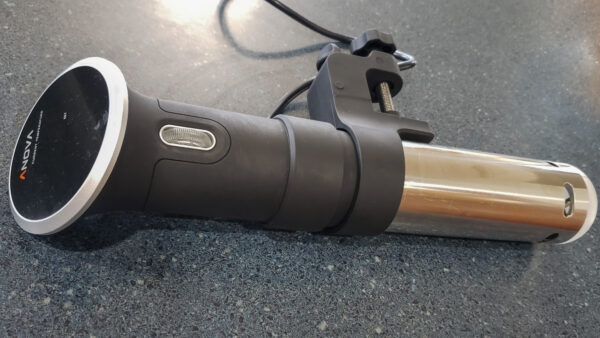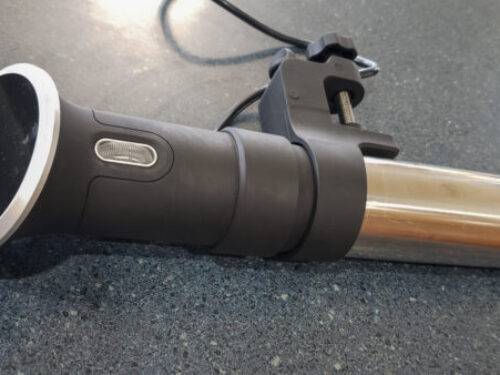Disclaimers: Our site uses demographic data, email opt-ins, display advertising, and affiliate links. Please check out our Terms and Conditions for more information.
Sous vide is a pretty inventive cooking tool that we use on a weekly basis. You may have heard of sous vide being referred to as immersion cooking before, and you may know that it is heralded for its perfect temperature control, but have you ever really stopped to think “how does sous vide work”?
In this one, we want to break down how sous vide functions, dive into why it is perfect for cooking, and even share a few pitfalls as well.
The Main Components of a Sous Vide
At its core, a sous vide has three main components- a heating element, a mixer, and the controls. You likely will not see the first two unless you remove the protective sheath from the device (as is shown in the above photo), but really that is all there is to it.
The heating element heats up water, the mixer circulates it within a vessel, and the controls help create a feedback loop to maintain the temperature outright- often to within about 0.5 or 1 degree Fahrenheit. That's it!
Some more expensive sous vide models may come with more features (like adjustable clamps or bluetooth/wireless to connect to your phone), but the basic construction of a sous vide is simply temperature control of a water bath via these three components. So, how is this used for cooking? Read on.
Applying Heat to Food is Cooking (Literally)
If we take a step back and think about cooking in a broad sense, it can be boiled down to simply adding heat to food in order to create a final product that is more enjoyable than its raw form (and, in the case of some foods like meat, making it safe to consume outright).
Baking in your oven? It is the application of heat. Cooking on a stovetop? Application of heat. Grilling? Uses heat. Smoking? Another use of heat plus smoke for added flavor.
All of these applications of heat have one flaw- your skill matters.
Apply too little heat when baking and your cake won't set. Apply too much heat when grilling and your steak will be well done and charred. The mark of a good chef is the skill in getting it just right, and most of us probably have one form of cooking we don't like purely because we're not skilled at it- I'm baking, my wife is grilling (thankfully, we each love the alternative, so it works out).
Sous vide is an equalizer in that you can apply the exact amount of heat into your food and have it be cooked to your tastes every single time.
Cook a steak in sous vide set to 130 °F (medium-rare) and, with enough time, you can be assured that the inside will be at 130 °F without fail. It'll still need a finishing sear, but if you have an instant read thermometer you'll ensure you never go above your target temperature outright. Want a ramen egg (145 °F)? Chuck an egg in for 60 minutes and you know it'll be perfectly set. Repeat this for most foods you'd otherwise cook on a stovetop, grill, or in the oven (non-baking) and you'll have a similar result.
Some of the finest fish I've ever had in my life came from my sous vide. Cooking it was as simple as placing a bag containing seasoned fish, butter, herbs, and a lemon slice or two, in the sous vide, at 120 °F, and waiting about 30-60 minutes pending thickness.
As you control the exact temperature for your cooking, having overcooked food is a thing of the past with sous vide insofar as your temperature setpoint is correct for your meal.
But there are a few pitfalls worth highlighting as well.
A Few Sous Vide Drawbacks to Note
In the above section, we highlighted that cooking is the application of heat and sous vide inherently can't over apply heat in the way you would imagine from traditional cooking (assuming your recipe is accurate, of course). As with any cooking style, undercooking is always a concern, and this can be alleviated by simply allowing your food to cook for longer in most cases.
- *Safety note: General safety wisdom is that food should not be under 140 °F for more than four hours. As such, we always factor this in as an upper time limit for cooks at lower temperatures (i.e. steaks at 130 °F should be removed from sous vide, seared, and served in a max of four hours); however, you can also work off pasteurization charts to get around this for some cooks as well as bacteria can be killed at lower temperatures with extended cooking times.
In fact, sous vide is slow cooking at its finest as you are exchanging time for perfect temperature control. Whereas you may be able to sear a fish filet on a stovetop in a couple of minutes, you'll likely have it in your sous vide for 30-60 minutes. I've had steaks go almost to the end of that four hours window and roasts go closer to 40 hours as the extra time does wonders for changing texture in meat.
Trading time for perfection? We're in every single time.
But as sous vide is really a set-it-and-forget-it tool, to us, it is no different than cooking in a crockpot. We put the food in and forget about it until its pre-determined “finished” point. The amount of time we actually spend cooking is, for the most part, the same as any other cooking method. So if we want to enjoy a nice steak at 6pm, we put it in the sous vide between 2 and 3pm, walk away, and return with just enough time to sear and serve.
This brings up another point in that sous vide does not, in any way, shape, or form, result in the Maillard Reaction taking place. This is the chemical reaction between enzymes and reducing sugars that occurs in extreme heat (minimum 280 °F) that is most often used for browning meats and vegetables. As sous vide takes place at below boiling conditions, you'll need to couple your cooks with a sear on a grill or cast iron skillet in some cases.
Trust us when we say, it is worth it. A steak without the Maillard Reaction is boring, but a thick steak cooked in sous vide with the Maillard Reaction as a finish? Well, that is heavenly.
Overall, the science how how a sous vide works is pretty simple. It is all about the precise application of heat over time. Set it, forget it, and maybe add on a finishing sear to meat and enjoy food the way it was meant to be enjoyed- at the perfect temperature!
Read More About Sous Vide
Want to learn more about sous vide cooking? Check out some of our top posts:







